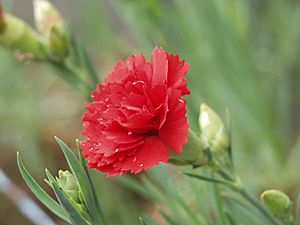Carnation facts for kids
Quick facts for kids Carnation |
|
|---|---|
 |
|
| Red carnations | |
| Scientific classification | |
| Genus: |
Dianthus
|
| Species: |
caryophyllus
|
The carnation (scientific name: Dianthus caryophyllus) is a beautiful flower also known as the clove pink. It belongs to the Dianthus family. This flower likely comes from the Mediterranean region. However, because people have grown it for over 2,000 years, its exact natural home is not fully known.
Carnations are perennial plants, meaning they live for more than two years. They can grow up to 80 centimeters (about 31 inches) tall. Their leaves are a cool grayish-green or blue-green color and can be up to 15 centimeters (about 6 inches) long. The flowers are usually 3–5 centimeters (1–2 inches) wide and smell sweet. Wild carnations are bright pinkish-purple. But people have grown many different types, called cultivars, in colors like red, white, yellow, and green.
Some carnations do not have a strong smell. These are often used as small flower decorations, called boutonnieres, for men to wear on their jackets.
Contents
About Carnations
Growing Carnations
Carnations need a special kind of soil to grow well. They like soil that drains water easily and is neutral or slightly alkaline. They also need lots of sunshine. Many different types of carnations have been created for gardens. Some popular ones include 'Gina Porto', 'Helen', 'Laced Romeo', and 'Red Rocket'.
Did you know that Colombia grows the most carnations in the world?
Carnations for Special Days
Carnations are often worn or given on special occasions and holidays.
Mother's Day
In 1907, Anna Jarvis chose the carnation as the symbol for Mother's Day. This was because it was her mother's favorite flower. This tradition is still followed in the United States and Canada on the second Sunday in May. Anna Jarvis picked the white carnation to show a mother's pure love. Today, a red carnation is often worn if your mother is alive. A white one is worn if she has passed away.
Parents' Day and Teachers' Day
In Korea, carnations show admiration, love, and thanks. Red and pink carnations are worn on Parents Day (May 8th). This day celebrates both mothers and fathers. Sometimes, parents wear a small bunch of carnations on their left chest on Parents' Day. Carnations are also worn on Teachers' Day (May 15th).
May Day and Revolutions
Red carnations are worn on May Day in some countries. This includes places like Austria and Italy. They are a symbol of workers' rights and movements. The red carnation is also a symbol of the Portuguese Carnation Revolution.
Green Carnations
Green carnations are sometimes worn for St. Patrick's Day. The famous Irish writer Oscar Wilde was known for wearing them.
Women's Day in Poland
In Poland, during the time of the People's Republic of Poland, carnations were often given to women on International Women's Day. They were given along with things that were hard to find back then, like tights, towels, soap, and coffee.
Oxford University Tradition
At the University of Oxford in England, students traditionally wear carnations for all their exams. They wear a white carnation for the first exam, a pink one for exams in between, and a red one for the very last exam. One story says that students used to dip their white carnation in red ink between exams. By the last exam, it would be completely red!
Wedding Anniversaries
Carnations are the traditional flower for a first wedding anniversary.
Carnation Colors
Carnations do not naturally make a blue color. This means you won't find a blue carnation growing in nature. You also can't create one using traditional plant breeding methods. Many other popular flowers, like roses, lilies, tulips, and chrysanthemums, also cannot naturally be blue.
Around 1996, a company called Florigene used genetic engineering to create a blue-mauve carnation. They took genes from petunia and snapdragon flowers. This new carnation was called 'Moondust'. In 1998, a violet carnation called 'Moonshadow' was also created. By 2004, three more blue-violet or purple types of carnations had been developed.
Related pages
Images for kids
-
Carnations painted by Pierre-Joseph Redouté
See also
 In Spanish: Clavel para niños
In Spanish: Clavel para niños






